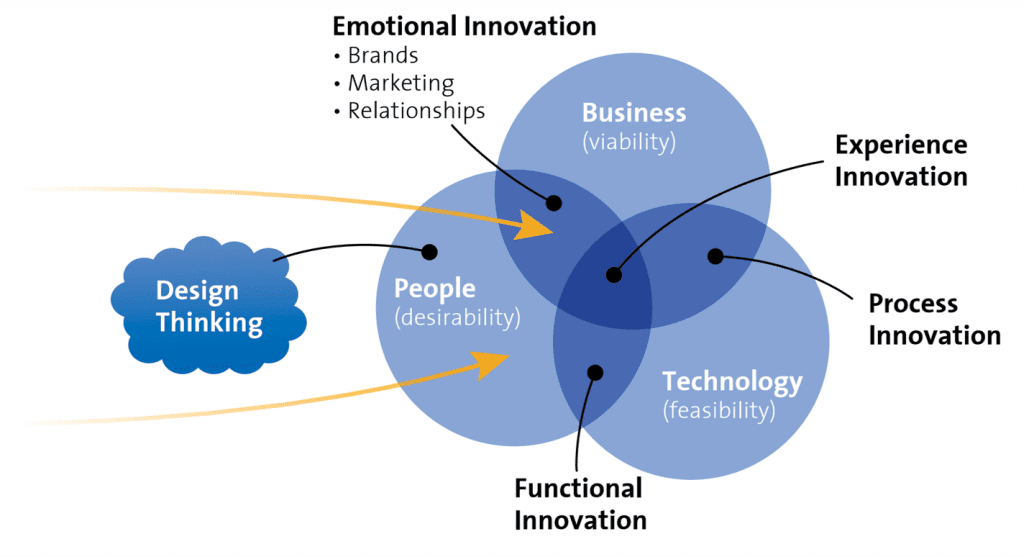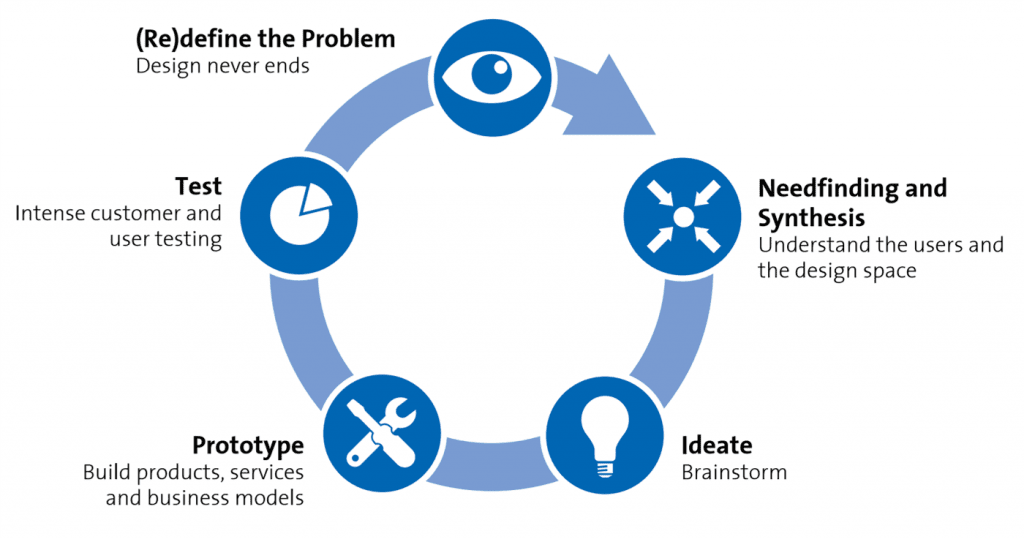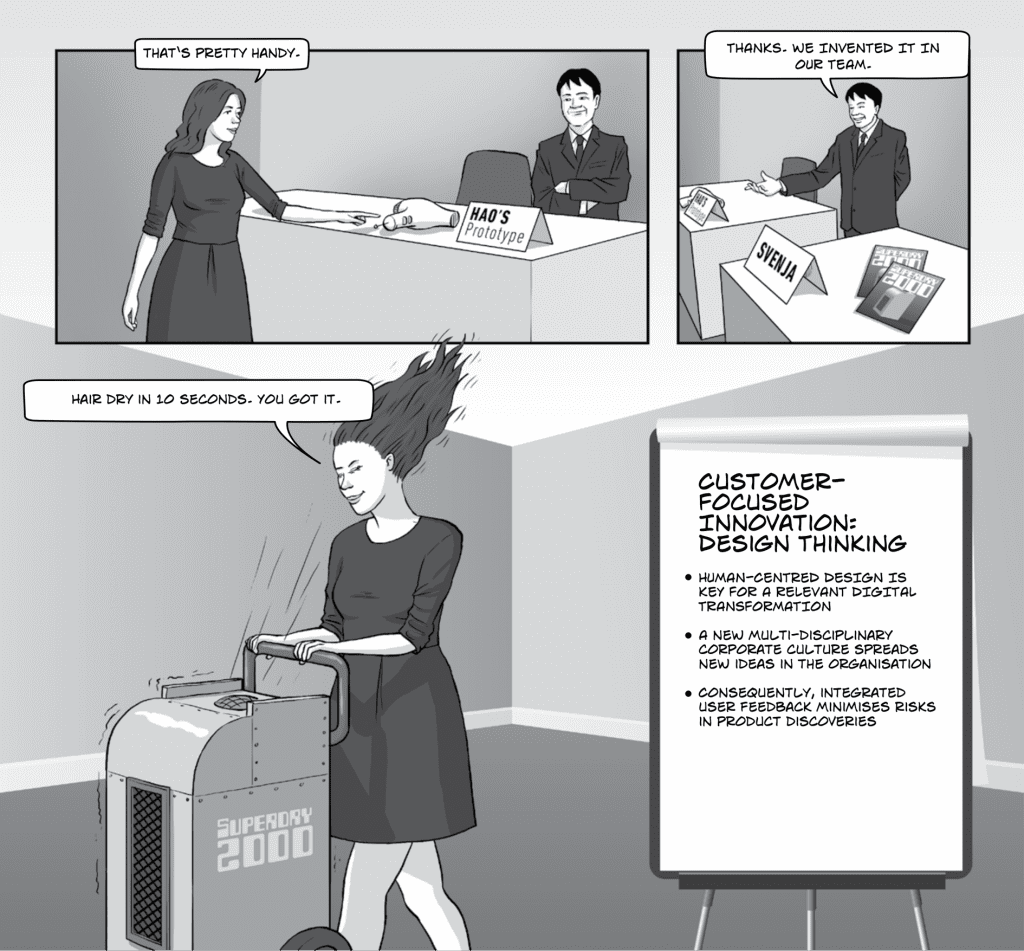In 2004, the American magazine Businessweek featured an innovation and design firm, IDEO, in a cover story describing an approach IDEO was applying to every business challenge: Design Thinking. The story had a profound impact, and since then Design Thinking has influenced many businesses and organisations worldwide by defining a new way of interaction between corporations and their customers (for example Procter & Gamble,[1] SAP,[2] Deutsche Telekom,[3] Airbnb[4] and Zoo Hannover[5]) in addition to becoming an academically taught discipline.
Design Thinking constitutes a user-centred, insight-driven, explorative and iterative approach to problem-solving.
It allows companies to adapt their products to the customers’ needs. It allows businesses to build the right things right, or in other words, to make user-centred decisions on what to build, in an agile and iterative fashion. As such, Design Thinking is a tool to deliver swift innovation focused on customer needs and is therefore well-suited to digital innovation projects. The mere existence of such a method creates competitive pressure to apply it. Design Thinking is based on three pillars:
- Process: Always follow an insight-driven approach, integrating the users at the very beginning of every project to (re)define the scope, to test the assumptions as rapidly as possible, not to sell your ideas, but to learn whether you are on the right track. This allows you to adjust and pivot before investing too much into implementation, and to reduce the risk of product failure at the beginning of every product or service concept stage.
- People: Project team members should bring experience from different disciplines to integrate their perspectives from the very beginning of the project.
- Space: Ideally, the team should apply the Design Thinking process in an organisational and spatial environment that enables the team to be creative.
Followers of the Design Thinking methodology believe that a successful innovation happens when an idea satisfies the following criteria: it is technologically feasible, it is economically viable and it is desirable by users and customers.

Taking the St. Gallen definition of Design Thinking, the process consists of five sequential and iterative phases (see figure below), with underlying tools and techniques at each stage, in order to change habits towards a more entrepreneurial mindset:
- Empathise: The team members work to fully understand the experience of the user for whom they are designing by observing, interacting and immersing in the user’s experience.
- Define: The insights and findings from the empathise phase are structured and synthesised in order to make the first design decision based on the user’s point of view.
- Ideate: Based on the user’s point of view, the team generates a variety of solutions to the user’s problem.
- Prototype: The best ideas developed are materialised into prototypes. An interaction with these prototypes brings new information and more empathy.
- Test: The aim of the last phase is not to sell an existing idea, but to verify or falsify a hypothesis (idea) – can it solve a user’s problem sustainably or does the team have to perform another iteration?

In general, Design Thinking is applicable to every problem that has a user interface. It is especially useful when addressing what Roger Martin referred to as ‘wicked problems’, which are ill-defined or tricky (as opposed to wicked in the sense of malicious). With ill-defined problems, both the problem and the solution are unknown at the outset of the problem-solving exercise. This is as opposed to ‘tame’ or ‘well-defined’ problems, where the problem is clear and the solution is available through some technical knowledge. For wicked problems, the general thrust of the problem may be clear; however, considerable time and effort is spent to clarify the requirements.
A large part of the problem-solving activity, then, consists of problem definition and problem shaping.
In the last decade, Design Thinking has become synonymous with successful user-centred orientation, especially due to successful integration of its methodology into organisations (including the above-mentioned and other companies such as Cirque de Soleil[6] and IBM[7]).
_____
[1] Chiranjeevi, C. V.: ‘P&G’s “Design Thinking” Initiative: The Innovation Lessons’, IBS Case Development Centre, 2009.
[2] Saucedo, M., Shiv, B.: ‘SAP Design Thinking, Part A’, Harvard Business Review, 2016.
[3] Deutsche Telekom: ‘eEtiquette@work: Zusammenarbeit in der digitalen Welt’, Deutsche Telekom, 2014.
[4] Gallagher, L.: ‘The Airbnb Story: How Three Ordinary Guys Disrupted an Industry, Made Billions . . . and Created Plenty of Controversy’, Houghton Mifflin Harcourt, 2017.
[5] Schmitt, C.: ‘Goldrausch im Gehege’, Die Zeit Online, 2010.
[6] Shamiyeh, M.: ‘Creating Desired Futures: How Design Thinking Innovates Business’, Birkhäuser Architecture, p. 29, 2010.
[7] Cannistra, K.: ‘Case study: IBM Bluemix’, IBM Design, 2014.


